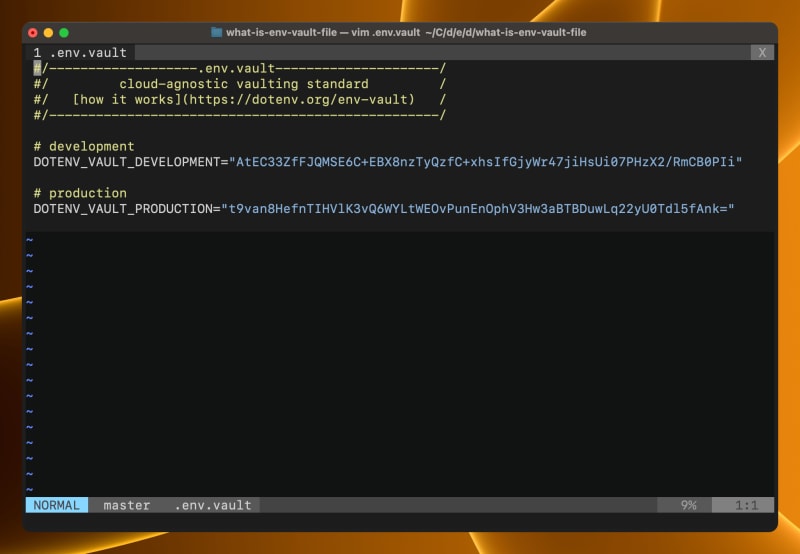It’s an encrypted copy of your .env files.
It is easiest to understand if you generate one. So let’s do that. Then I’ll show you how to use it in production. Lastly, we’ll talk about its security advantages.
Generating
We’re going to use the command npx dotenv-vault local build.
Prerequisites
Enter a project where you already have .env.* file(s) and have installed dotenv.
For example, I have a project with 3 files in it. See example code.
- index.js
- .env
- .env.production
// index.js
require('dotenv').config()
console.log(`Hello ${process.env.HELLO}`)
# .env
HELLO="development"
# .env.production
HELLO="production"
When I run node index.js I get the expected output Hello development.
$ node index.js
Hello development
Let’s build the .env.vault file.
Generate .env.vault
Run the local build command.
$ npx dotenv-vault local build
You will see a .env.vault file that looks something like this.
#/-------------------.env.vault---------------------/
#/ cloud-agnostic vaulting standard /
#/ [how it works](https://dotenv.org/env-vault) /
#/--------------------------------------------------/
# development
DOTENV_VAULT_DEVELOPMENT="AtEC33ZfFJQMSE6C+EBX8nzTyQzfC+xhsIfGjyWr47jiHsUi07PHzX2/RmCB0PIi"
# production
DOTENV_VAULT_PRODUCTION="t9van8HefnTIHVlK3vQ6WYLtWEOvPunEnOphV3Hw3aBTBDuwLq22yU0Tdl5fAnk="
It contains two keys.
DOTENV_VAULT_DEVELOPMENTDOTENV_VAULT_PRODUCTION
These contain encrypted copies of:
- your
.envfile - your
.env.productionfile.
A .env.keys file was also generated. These keys decrypt the contents of DOTENV_VAULT_${ENVIRONMENT}.
$ npx dotenv-vault local keys
#/!!!!!!!!!!!!!!!!!!!.env.keys!!!!!!!!!!!!!!!!!!!!!!/
#/ DOTENV_KEYs. DO NOT commit to source control /
#/ [how it works](https://dotenv.org/env-keys) /
#/--------------------------------------------------/
DOTENV_KEY_DEVELOPMENT="dotenv://:key_f4516b0077d9aefad9fa7b36cec570e05dcb7cd6d5de1dac2562b6421af7d185@dotenv.local/vault/.env.vault?environment=development"
DOTENV_KEY_PRODUCTION="dotenv://:key_18a137f844e3511022dbf1de2b1bd5e3bd6d1ef4c78988e2521ce9f05abc506a@dotenv.local/vault/.env.vault?environment=production"
See the pattern? A .env.${ENVIRONMENT} file corresponds to a DOTENV_VAULT_${ENVIRONMENT} secret and DOTENV_KEY_${ENVIRONMENT} decryption key.
Try decrypting the contents of DOTENV_VAULT_PRODUCTION.
$ npx dotenv-vault local decrypt 'dotenv://:key_18a137f844e3511022dbf1de2b1bd5e3bd6d1ef4c78988e2521ce9f05abc506a@dotenv.local/vault/.env.vault?environment=production'
HELLO="production"
Great! It’s decrypting successfully. Next, let’s put this to use in production.
Production
- Commit
.env.vaultto code - Set DOTENV_KEY on server
- Deploy your code
At runtime your encrypted secrets will be injected into your code just-in-time.
Try it on your machine with this simple example.
$ DOTENV_KEY='dotenv://:key_18a137f844e3511022dbf1de2b1bd5e3bd6d1ef4c78988e2521ce9f05abc506a@dotenv.local/vault/.env.vault?environment=production' node index.js
[dotenv@16.3.1][INFO] Loading env from encrypted .env.vault
Hello production
As you can see, it loads your env from your encrypted .env.vault file and successfully outputs Hello production. Elegant!
(Other languages are supported too. See dotenv.org/docs)
Security Advantages
Do you remember the CircleCI data breach? An attacker gained access to everyone’s environment variables putting their software products at major risk.
But if you were using .env.vault files, you were not at risk. Why?
The attacker solely gained access to environment variables, not code. He had your DOTENV_KEY but not your .env.vault file. He needed both to access your secrets.
This takes the Twelve-Factor App’s principle of strict separation of config from code to the next level - where even your config is separated.
This leads to some great second order effects.
- You are no longer scattering your secrets across multiple third-parties and tools
- Your secrets are easier to manage in one central place close to your code which means less chance of fat-fingering or forgetting to set a secret
- You add more friction to attackers and remove friction for yourself - no more hard work managing secrets across multiple servers
I’d encourage you to give .env.vault files a try. I think you will like them after the initial adoption hump. They are simple files that don’t require any additional secret manager processes to be kept running.
.env files were simple, useful, and added additional security. .env.vault files maintain that same spirit while adding a much higher level of security. What do you think, let me know at @dotenvorg or @motdotla.
dotenv-vault — A secrets manager for .env and .env.vault files.
If you are looking to also manage your .env and .env.vault files across a larger team, complete with permissions, versions, and history then create a Dotenv Account. It’s free with premium features.




Top comments (0)